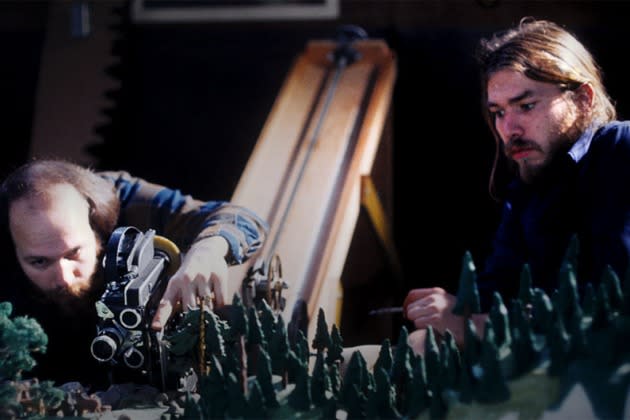‘Claydream’ Review: Doc’s Portrait of an Animation Innovator Is Inspired and Poignant

In proudly weird Portland, Oregon, far from the Hollywood moviemaking machinery, an animation empire arose in the mid-’70s. It was fueled by a hippie-collective exuberance and one man’s “burning ambition,” as a colleague describes the enterprising energy of Will Vinton, the company’s driving force, in the engaging and insightful Claydream.
With incisive use of clips from the Vinton catalog and discerning interviews with Vinton and those who knew him, Marq Evans has made a film that pays tribute to its subject but is no starry-eyed celebration. Not unlike the characters Vinton and his collaborators brought to the screen through Claymation (a Vinton coinage and registered trademark), the doc combines exhilarating whimsy with dark and complex emotions. And any film that incorporates deposition footage is not likely to be headed toward a simple happily-ever-after.
More from The Hollywood Reporter
Bill Paxton's Family Reaches Settlement With Cedars-Sinai Medical Center in Wrongful Death Suit
SAG-AFTRA National Board Approves New Exclusivity Terms With Studios
Those legal proceedings pitted Vinton against Phil Knight, the CEO of Nike and, beginning in 1998, a major investor in the then-struggling stop-motion studio. Theirs was a conflict between two ultra-driven entrepreneurs who had put Oregon’s largest city on the map. But as Vinton would discover the hard way, he was the David to the sneaker mogul’s Goliath. The sharply edited deposition footage (Lucas Celler and Yakima did the doc’s cutting) more than suggests that the animator was swimming with sharks.
As organized, dauntless and practical as he was when it came to building a company and producing creative work, bigger-picture business decisions weren’t his strength. Will Vinton Studios became world-famous for its work with the California Raisin Advisory Board. Featuring sun-dried fruit singing and dancing to “Heard It Through the Grapevine,” the ads achieved the ’80s version of viral. He would win an Emmy for a primetime Christmas special featuring the Raisins. But Vinton lost out big-time on licensing for the merch that would follow — an income pipeline that would prove monumental. Later, he would reject a buyout offer from upstart Pixar that would have made him a major stockholder in that corporation.
A product of small-town Oregon, Vinton drew inspiration from the counterculture scene in ’60s Berkeley, the extravagant architecture of Antoni Gaudí, and his father’s 16mm home movie camera. In college, he organized clay-sculpting parties, and before long he’d set up an animation studio in the house he and his first wife shared in Portland. There, he and artist Bob Gardiner — “a mad genius,” per animation maestro Bill Plympton — took stop-motion clay animation, an old form, to a new, experimental edge. (Until they mastered how to control their characters’ movements, making many of them swaying winos was a handy solution.)
Vinton and Gardiner won an Oscar for their 1974 short Closed Mondays, but their partnership would soon end, Gardiner’s unpredictability a bad fit for the laser-focused Vinton and his dreams of becoming a movie maestro à la Disney. Gardiner’s struggles and bitterness would surface, sometimes in the form of death threats, every time Will Vinton Studios made headlines with its triumphs. Initially set up behind a barbershop, the company in those early days was, on the basis of interviewees’ testimony, a magical place with a strong sense of family. As voice actor Michele M. Mariana, who provides some of the doc’s most memorable and deeply felt comments, puts it, the Claymation workshop was propelled by a “melodic” energy.
But Vinton wasn’t able to sustain the melody. The studio hit a creative standstill. Employees became disenchanted, some believing that they weren’t being properly credited for their work. That Vinton kept everyone on salary with benefits, as opposed to the more cost-effective Hollywood model of contract workers, added to the company’s financial stress. There would be reinvention (computer animation) and reinvigoration, C-suite shake-ups and infusions of capital from investors. Though at one point Michael Jackson would clamor to work with him (footage of the singer is presented in terms of who he was then, and it’s left to the viewer to navigate the disconnect between more recent revelations and the image of a revered superstar in his prime), ultimately Vinton would find himself on the outside looking in. His studio would be reborn and, under a different name, reach the filmmaking heights that Vinton aspired to.
His Disney dreams, which even included plans for a theme park, went unrealized. The only feature-length Claymation film he directed, The Adventures of Mark Twain, was five years in the making; its ambitious, adult-oriented themes didn’t click with audiences. Yet the ever-hopeful Vinton, who died in 2018, proved resilient. And his ability to keep moving forward was, at least in part, a function of his knack for compartmentalizing.
Evans’ take on Vinton is sympathetic, but his film’s strength is its attention to the complexities of a man who was closed off from his own feelings. The portrait that emerges from the new interviews and well-curated archival footage is at least as compelling as the twisty irreverence of the characters Vinton and his collaborators brought to life. One of his sons recalls how undemonstrative he was, and how they connected best by working together on creative projects. His second wife, Susan Shadburne, who worked at Will Vinton Studios as a writer, calls him “a mystery to himself”; he ended their 12-year marriage without so much as a discussion. A friend wonders about the connection between the illness he kept hidden and the emotions he didn’t express.
For all his mustachioed cheer, Vinton kept a lot under the vest — and surely that included his disappointments. In Claydream he gets to tell his story, and the pauses and silences that Evans captures resound as movingly as the words.
Best of The Hollywood Reporter

 Yahoo News
Yahoo News 